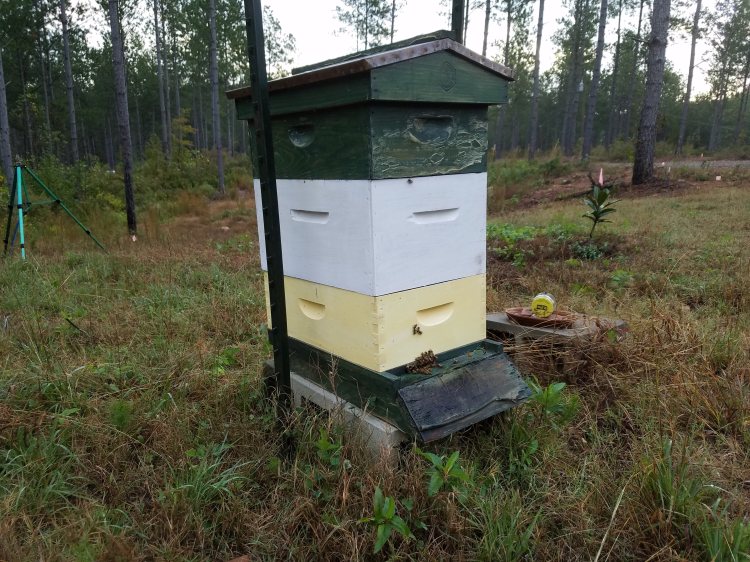
It’s only 62 degrees this morning, but bees in the English hive are already out foraging. It’s no wonder that these bees are well set up for the cold weather that is just around the corner; of all our hives, they have the most honey stored. This is our go-to hive for requeening because the colony has always been friendly, the queens have always been great producers, the bees are hygienic, and the bees are the first out the door to forage.
At the other end of the spectrum, we have a hive that has no stored resources despite all the goldenrod that surrounds the apiary. Our records show that they haven’t stored any resources since we brought them back from the sunflower patch — and they had nothing then. If I’d been able to find the queen yesterday, I’d have combined them with another weak but productive hive. Those guys have increased their numbers by a full frame of bees and they have nectar and bee bread stored. I can’t risk combining them without eliminating the lazy-genetics queen, so they have two weeks to pick up their game! We put a candy board on the hive yesterday (and reduced the entrance down to a single bee width), so maybe that will help them. Maybe it will make them more dependent on us.
We’ve also had to do our part in the preparation. Our varroa mite treatments were interrupted by the two hurricanes that passed close by, but we treated the last hives yesterday. We used Api Life VAR for most of the hives simply because it dissipates and doesn’t have to be removed. We used ApiVar for the last two hives simply because we still had some; we will need to remove the strips after 42 days. We’ve had good results with both products in the past and we do try to rotate treatment methods to prevent mite resistance.
A non-chemical way to break the mite cycle occurs when we requeen because the brood cycle is interrupted. Of course, this is not a method we can take at this time of year. Not treating for mites risks loss of the colony, so to us that is simply not an option. Many experts consider varroa mites to be the main factor in winter colony losses.
The other steps we taken to set our bees up for success are reduction the entrance sizes to help each hive better defend against robbing, removal of queen excluders, and removal of superfluous supers and brood boxes. As temperatures drop, we need to minimize the volume that bees need to keep warm. The queen is not going to lay large amounts of eggs at this time of year, so we only need to allow for enough space to store the last resources naturally available out there. Queen excluders need to be removed because the bees may cluster above the excluder, leaving the queen cold and alone and likely to die. While she’s not laying much right now, they’ll need her in spring! As for robbing — it’s not just other bees that rob. We found a yellow jacket inside one hive yesterday and I blogged about the European Hornets that decimated hives a few weeks ago.
The final thing we’re still battling is small hive beetle infestation. Some hives have almost none, while other hives are mind-mindbogglingly full. Naturally, the hives with the most nectar are most attractive to the beetles, so they got extra beetle blasters yesterday. Two of our hives are always the most problematic, so we’ll relocate those hives in spring to see if that makes a difference. Both have been requeened. Both used to be mean and are now calmer. Mean or calm made no difference in beetle numbers, so we suspect it’s location. Still, the other two hives on the stand have minimal beetle populations, so it’s going to be trial and error to figure out what’s going on with them.
Well, I want to get outside and enjoy another couple of hours among the trees before heading back to the city. We’ve finished all the crucial tasks, so now it’s time to just relax and enjoy — and tire the dog out before sticking her in the car for the 5 hour commute!
Excellent write-up and overview of winter preparations. Thanks!
LikeLike